
It’s something that keeps good leaders up at night:
Are my employees happy?
Will my top performers stay?
What more could I be doing to keep them?
Learning how to retain employees is a top concern for today’s CEOs and HR pros … and for good reason.
Get Your Free Retention Checklist For Managers
According to a survey by consulting firm Mercer, voluntary turnover is up 5% since 2011. Job-hopping, it seems, is increasingly becoming the norm, thanks in part to a workforce comprised of more and more Millennial workers, who are likely to have twice as many jobs over their lifetimes as baby boomers.
This trend is only amplified in a recovering economy, where workers can change jobs with more frequency and fewer consequences.
In a hurry? Check out our favorite recognition platforms designed to improve employee retention at your company:
| Bonusly | 🥇 Recognize and reward employees for their achievements and milestones | Visit Bonusly |
| Stadium | 🎁 Award them an eGift | Visit Stadium |
| Motivosity | 🌟 Engage and retain employees with recognition, rewards, surveys, and more | Visit Motivosity |
| Guusto | 🏆 Reward your team’s priorities, culture, and performance with premium incentives | Visit Guusto |
| Nectar | 😃 Peer-to-peer recognition, Amazon integration, boost your engagement and retention | Visit Nectar |
| 👉 Compare more HR-vetted and approved options here | ||
All this turnover, of course, is expensive. A study from the Center for American Progress found that the average cost of replacing an employee was about 21% of her salary.
As important as turnover is, you’d think there would be a plethora of great advice on the subject. But we’ve been underwhelmed by the information out there explaining the ways to retain employees… most of it vague, abstract, and frankly, not very useful.
That’s why we’ve compiled the following 6 case studies, highlighting examples and takeaways from the companies who are winning the war for talent and getting the retention question right — so you can see what REAL retention strategies look like in ACTION, and adapt them to the specific needs of your company.
How To Retain Employees: Case Study #1 The Trade Desk
 Jeff Green, CEO at The Trade Desk, sees time as the most valuable commodity we have as human beings, and when someone chooses to give their time to an employer, it’s the ultimate compliment. As The Trade Desk grew and early-stage employees began to hit tenure milestones, Jeff realized that there wasn’t an anniversary awards program in place that authentically expressed to employees the level of gratitude he had for their time, energy, and dedication to the business. They needed a partner who could recognize employees in a meaningful way, and that celebrated their diverse, personal interests.
Jeff Green, CEO at The Trade Desk, sees time as the most valuable commodity we have as human beings, and when someone chooses to give their time to an employer, it’s the ultimate compliment. As The Trade Desk grew and early-stage employees began to hit tenure milestones, Jeff realized that there wasn’t an anniversary awards program in place that authentically expressed to employees the level of gratitude he had for their time, energy, and dedication to the business. They needed a partner who could recognize employees in a meaningful way, and that celebrated their diverse, personal interests.
The Trade Desk found Blueboard in 2018, and a wonderful partnership was born. Now, when TTD employees hit anniversary milestones, they get to celebrate with a Blueboard reward from a wide menu of hand-curated experiences to enjoy with their loved ones (like hot air balloon rides, pottery lessons, and adventurous glamping trips).
Takeaway #1 – Scale your personalized and meaningful recognition efforts
Scale your personalized and meaningful recognition efforts Click To Tweet
Administering anniversary awards for thousands of employees is no small task. That’s why Jess Wagner, Global Engagement Manager, happily adopted Anniversary Engine, a feature in the Blueboard platform that allows admins to easily automate reward delivery to employees on their anniversary date.
It’s the perfect solution for growing companies who want to deliver personalized rewards at scale. And to continue scaling the celebrations, TTD distributes a company-wide monthly Anniversaries newsletter featuring personalized employee achievement spotlights written by their manager. These efforts ensure the program is well-socialized, building anticipation amongst TTD employees looking forward to their own Blueboard experience.
Takeaway #2 – Build connection and culture by celebrating culture champions
Build connection and culture by celebrating culture champions Click To TweetIn the wake of migrating to a fully remote work environment, TTD employees stepped up across the globe to build connections and culture. Through engagement efforts like employee-led home haircut tutorials, morning yoga classes, or facilitating Pride Month panels, employees championed life at The Trade Desk and embodied their company values.
TTD partnered with Blueboard to launch a new spot recognition program to celebrate these culture champions. TTD employees receive Blueboard rewards for their above and beyond contributions and authentic display of company values.
How To Retain Employees: Case Study #2 Netflix

Over the last decade, Netflix has rewritten the rules in the cable, video rental, and VOD spaces. Disruption, you could say, is in their DNA.
So when Patty McCord, the company’s first Chief Talent Officer, arrived at the company, she refused to take a business-as-usual approach.
Her novel yet practical style sent a shockwave through the business world, and the culture deck that she developed alongside Netflix CEO Reed Hastings has been hailed as a defining document of Silicon Valley.
Here’s what Netflix taught us on how to retain employees:
Takeaway #3 – Take care to only hire “A” players by focusing on character in the hiring process
Take care to only hire A-players by focusing on character in the hiring process Click To TweetAccording to tradition thinking, your organization will always be stratified – there will be a small group of “A” players (high performers who provide the bulk of innovation and results), a large group of average performers, and another small group of poor performers who will either have to be replaced or will leave due to lack of engagement.
McCord asked, if we know how much more value they provide, why hire anything other than “A” players?

Identifying these “A” players in the hiring process is a challenge, but Netflix found that the key was to focus on character as much as skills or experience.
McCord and her team took great care to only hire mature, “fully formed adults” who put the success of their teammates and the organization before their own.
For McCord, hiring top-talent constituted the ultimate perk.
The benefit to the company is twofold—having more “A” players means more productive and motivated individuals, but it also means a better, more engaging working environment for everyone.
Of course, hiring more top talent likely means a more involved hiring process and higher starting salaries, but the approach has apparently worked for Netflix, who recently beat HBO’s 17-year streak of most Emmy nominations in a year.
“The best thing you can do for employees—a perk better than foosball or free sushi—is hire only ‘A’ players to work alongside them,” she wrote in the Harvard Business Review. “Excellent colleagues trump everything else.”
This insistence on surrounding top talent with other top-talent is a key driver in the company’s above-average retention rate.
Takeaway #4 – Treat employees like adults
Treat employees like adults Click To TweetAccording to McCord, the best thing to do once you hire fully formed adults… is to treat them like adults.
In practice, this means an expense policy that’s just five words long (“act in Netflix’s best interest”) and things like unlimited vacation time, which sends the message that Netflix trusts their employees to do the right thing for the business. Most recently, the company garnered international attention by offering salaried employees up to a year of paid paternity leave.
Policies such as these encourage employees to stay for more than just the cushy benefits. They convey a sense of value and trust—in other words, they tell employees that they are valued for more than just the profit they create. This is one of the great advantages of hiring “A” players: given ample time and space and minimal micromanagement, they will produce great work for their company.
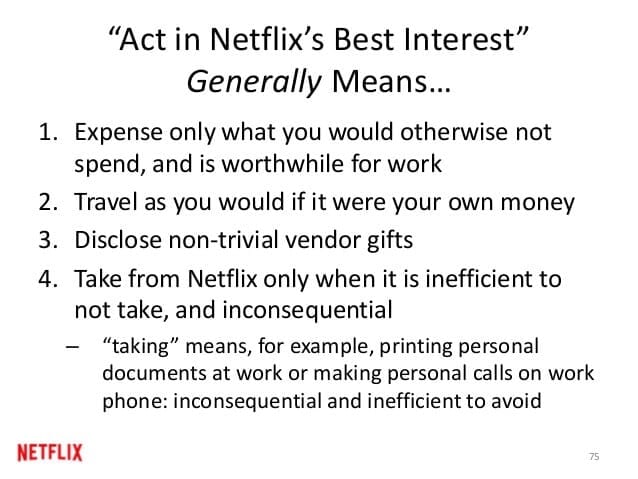
Above all else, it’s this insistence on treating people like trusted partners – something unthinkable in the command and control management styles of days past – that has contributed to Netflix’s above average retention rate.
Takeaway #5 – Develop great managers
Develop great managers Click To TweetAll effective retention strategies must include a plan to develop great managers.
After all, managers are the direct link between the C-suite and the rest of the org, and are responsible for executing leadership’s strategy and vision. Good managers aren’t necessarily star performers – they are leaders first, and doers second.

At Netflix, leadership emphasized the importance of team building above all else.
“We continually told managers that building a great team was their most important task,” McCord wrote in HBR. “We didn’t measure them on whether they were excellent coaches or mentors or got their paperwork done on time.”
How To Retain Employees: Case Study #3 – Whole Foods

Whole Foods is the gold standard when comes to retention rates in the grocery business, an industry that’s traditionally fraught with high turnover due to long, at times unpredictable hours and a perceived lack of growth opportunities.
A study led by graduate students at Johnson and Wales University identified the main drivers of Whole Food’s impressive retention stats. Here’s what they concluded.
Takeaway #6 – Create a values-driven culture
Create a values-driven culture Click To TweetAccording to the researchers, it all starts with CEO John Mackey, who combines elements of the service- and values-leadership models with Japanese management philosophies to arrive at a style that emphasizes a sense of purpose.
In his oft-cited blog post “Creating the High Trust Organization,” Mackey makes the case that modern businesses need a higher purpose, in part, to help galvanize employees around a common cause. With 50% of employees feeling they have different values than their employers, it is vitally important to establish a set of company core values that employees can get behind.
Mackey codified Whole Foods’ purpose in the company’s core values, which include “Support Team Member Excellence and Happiness” and “Serve and Support Our Local and Global Communities.”
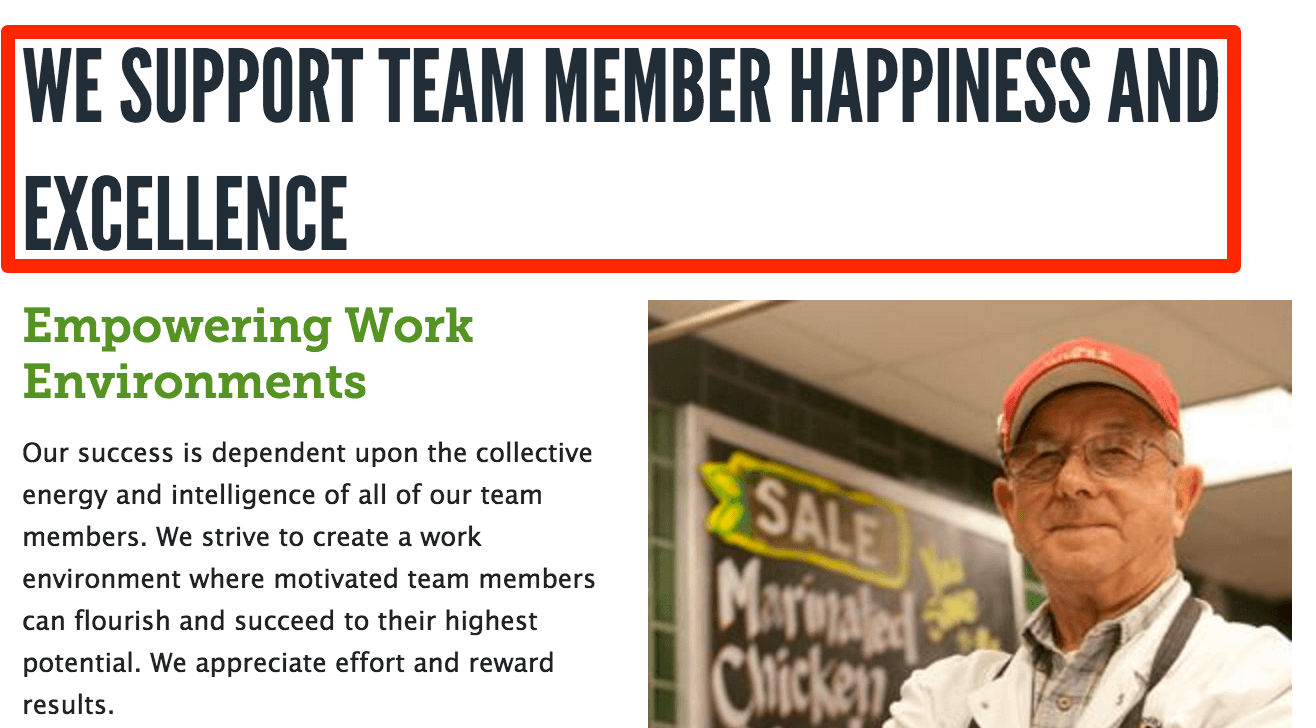
It’s this sense of purpose – which permeates the ranks and aids in decision making process from the highest to the lowest level – that helped attract the right fit for the organization, and therefore helped lead to the company’s low employee churn.
Takeaway #7 – Empower your team in the decision making process
Empower your team in the decision making process Click To TweetAnother key takeaway from the research – individual employees at Whole Foods are given far more credence than those at most companies, certainly more than those at other grocery chains. This is accomplishment mainly through the company’s unorthodox, egalitarian corporate structure.
There are no bureaucratic hierarchies at Whole Foods. Employees are divided into teams and empowered to interpret the company’s values and make most corporate decisions on their own.
Whether it is inventory changes, organizational decisions, or vital store investments such as POS systems, decisions are generally made in-store through a collaboration between managers and their employees.

“Whole Foods is a social system,” Mackey explained to Fast Company in 1996. “It’s not a hierarchy. We don’t have lots of rules handed down from headquarters in Austin.”
It’s a democratic system that requires consensus in order to function, a style influenced by Mackey’s affinity for Japanese management schools of thought. While this inevitably slows down the decision making process, the culture of ownership and investment it creates far outweighs any operational inefficiency it might cause.
Takeaway #8 – Let your employees be their true selves at work
Let your employees be their true selves at work Click To TweetThink back to the first time you walked into a Whole Foods. You might have been taken aback by the workers’ appearance:
No uniforms. Bohemian clothing. Lots of tattoos.
The word “hipster” may have even entered your mind.
While the workers’ heterogenous attire might seem like a minor detail, it actually reflects a core tenet of Mackey’s management philosophy.
In decades past, there has been an arbitrary distinction between our “professional selves” and our “actual selves,” the implication being that we behave artificially at work, and authentically in our private lives. This distinction extends to all aspects of culture and identity, including our language, dress, and grooming.
Mackey’s innovation was to obliterate this distinction, and to encourage his employees to express their authentic, true selves at work. This is particularly daring in the retail food service space, where employees frequently interact with customers and risk undermining the integrity of the brand.
By design, this allows for a level of personal autonomy that extends to dress and free expression. The researchers cited this autonomy as a key driver in employee satisfaction and Whole Food’s exceptional retention rate.
How To Retain Employees: Case Study #4 – Clif Bar & Company

Emeryville, California’s Clif Bar and Company is an inspiring success story with humble beginnings. The multi-million dollar business was built on a product that founder Gary Erickson dreamed up while riding his bike, and a prototype that he made in his kitchen – certainly no small feat.
But the company’s biggest accomplishment might be their astounding 97% retention rate. (And no, that’s not a typo.)
The Awesome Office podcast recently sat down with Clif Director of People Learning and Engagement to crack the code on Clif’s extraordinarily low level of voluntary turnover.
Here’s what they learned:
Takeaway #9 – Create a culture of ownership
Create a culture of ownership Click To TweetIn 2000, Erickson and his wife and co-owner Kit Crawford were toying with the idea of leveraging private equity to buy out an existing partner and prevent the company from being acquired by a multinational corporation.
But something didn’t feel right to Erickson. Deep down, he knew that the private equity deal didn’t align with the company’s mission and values. Ultimately, Erickson pulled out of a nearly final PE deal and opted for employee stock option program (ESOP), which had the added bonus of providing a sustainable benefit for employees and that was more consistent with the company’s core values (know as the five aspirations – sustain Clif’s people, business, brands, community, and the planet).

The ESOP helped build a culture of ownership that keeps employees invested in the success of the business and creates a personal, emotional connection to the company that few others can recreate – hence Clif’s astronomical retention statistics.
Takeaway #10 – Invest in personal(ized) growth and development
Invest in personal(ized) growth and development Click To TweetSmart companies know that people are their most important asset and that investment in personal development is an investment in the long-term health of the organization.
But Clif’s approach to development is a cut above, focusing not just on a development plan that would benefit the company, but one that supports the individual’s goals as well.

As Freitas told the Awesome Office show earlier this year, Clif works with employees to develop personal values, and then create a personalized growth and development plan that enables employees to live those values in their careers.
Guided by the company’s “Five Aspirations,” she also helped launch Clif Bar’s Sustainability Benefits Program — an initiative that helped the company earn numerous workplace awards, including ‘best place to work’ nods by Fortune and Outside magazines — but more importantly, rewarded employees for actions that were consistent with the company’s values.
Takeaway #11 – Leadership must walk the walk
Leadership must walk the walk Click To TweetPerks are certainly a factor in employee retention, but sometimes unspoken cultural norms or unwritten rules prevent employees from taking advantage of them, and therefore undermine their effectiveness as a retention strategy.
As Freitas told, the Awesome Office Show, the key is to get buy-in from management. Simply put, employee perks won’t get used unless upper management makes a conspicuous effort to participate in them.
Case in point – Clif CEO Kevin Cleary’s office is right next to the gym. Not to prevent employees from spending work time at the gym, mind you. To make sure they are.
At Clif, employees are encouraged to work out at the company’s state of the art onsite gym and are even paid up to two hours a week to work out. Cleary wants to see employees in there, making use of the facilities and making a commitment to their health. More often than not, he’s alongside them, getting his daily workouts in.
It’s this demonstration of long-term commitment to a culture of health and wellness that inspires Clif employees to stay year after year.
How To Retain Employees: Case Study #5 – Scopely

Los Angeles-based mobile gaming studio Scopely is known for its fun, irreverent culture.
What do we mean by fun?
Well, take their now infamous recruitment campaign, “the most interesting engineer in the world,” which enticed engineering candidates with lavish perks including a tuxedo, sex panther cologne, a spear gun, a year’s supply of beer, and the kicker, $11,000 in cash… wrapped in bacon.
That should give you some idea.
The strategy has paid off, as the company has been a veritable hit factory, cranking out six #1 games in a row, including The Walking Dead: Road to Survival, Yahtzee with Buddies, and Disco Bees.
Here’s what Scopely can teach you about retention:
Takeaway #12 – Celebrate anniversaries
Celebrate anniversaries Click To TweetAs the Harvard Business Review reported, a study of more than a million respondents found that workers are most likely to switch jobs at the one year mark. This phenomenon doesn’t stop at year one – the same study found a yearly trend, with a spike in the likelihood of voluntary turnover each successive anniversary.
The solution? Engage employees around yearly milestones.
True to form, Scopely celebrates anniversaries with hilarious, often absurd gifts, including custom-made samurai swords and one of a kind oil employee oil paintings that are hung around the office.
This novel approach to anniversaries has helped Scopely keep top employees happy and hold onto the talent they need to consistently produce top-selling mobile games.
Takeaway #13 – Failures are your friend
Failures are your friend Click To TweetThe surest sign of a toxic culture is one in which employees never fail.
The reason: a lack of failure means your employees are too afraid to take the risks that are necessary in order for your organization to grow.
As their former General Manager and current advisor Jason Weiss told the Awesome Office show, failure isn’t just tolerated at Scopely, it’s celebrated.
At the end of each week, the company holds a “Fail of the Week” session, during which a member of each team shares their most epic failure and what he or she learns from it.
The point isn’t to call out people’s mistakes but to acknowledge failure’s critical role in the growth process, as well as share the lessons learned from the experience.
How To Retain Employees: Case Study #6 – Big Spaceship

Bigspaceship, headquartered in Brooklyn, New York, is a strategy, design and technology consultancy that boasts clients such as JetBlue, Google and Nike.
They are known for having a no-nonsense, produce great work and don’t worry about the rest culture.
What does that mean?
Big Spaceship aims to strip back the corporate norms and behaviors in order to stay nimble, innovative and fun. Through their “humans are humans” approach to work, they not only attract world-class talent, but people stick around for the long haul too.
Big Spaceship’s strategy has not only helped get gushing reviews and case studies on their culture but has also secured their top spot among the competition for 13 years running.
They lay it out in a manual that highlights their weirdness as a secret ingredient for their success:
Takeaway #14 – Responsibility leads to caring more
Responsibility leads to caring more Click To TweetAt Big Spaceship, everyone works with a lot of autonomy. Not only because it encourages productivity and efficiency but also because with it improves engagement.

They’ve purposefully maintained a flat structure throughout their growth phases to ensure that each individual remains the expert of their domain. Everyone is a leader of their discipline and together they treat their work like a team sport. In the manual, the practice is described:
“Life is easy with someone is telling you what to do. It’s also boring and prevents you from being invested in what you are doing. Since you control your own destiny here, you’ll likely be more emotional about your work. We believe that is better than the alternative. Can you imagine coming to work each day and not caring? We can’t.”
This style forces employees to push themselves to tackle challenges and pick up a lot of responsibility. The side effect is that everyone is passionate about their work.
With that type of care, the office stays focused and interested in the opportunities ahead.
Takeaway #15 – Don’t underrate the value of fun
Don't underrate the value of fun Click To Tweet
At Big Spaceship, they follow 3 basic tenets to keep work passionate and combat burnout.
First, they believe that work and play should be intertwined. At this office, long gone are the days of compartmentalized work and life hours. Getting to know your coworkers is encouraged and embraced as a tool to produce better work, engage more deeply and build strong bonds.
One of their principals, “The health and harmony of your team is part of your job.”
Allowing human connection is sure bet way to gain the loyalty and devotion of your team. Nothing gets people excited to come to work like the opportunity to produce great work with their friends, right?
A couple strategies, favor face-to-face communication and start team rituals that will get people together on a regular basis.
And, we can’t talk about the importance of co-worker bonding without also mentioning our furry friends.

Big Spaceship accepts members of all shapes and sizes including those of the K9 variety.
Having dogs in the workplace is proven to increase happiness and relaxation. They can lower blood pressure and cortisol while increasing endorphins and oxytocin, the maternal bonding hormones. Aside from the physical benefits of having a dog, studies show that dogs can positively impact office morale and employee mental health.
Sounds like a win-win to us!
The third and final tenet of Big Spaceship’s strategy is allowing people to get out of their office chair and move.
They believe that it’s unhealthy and unproductive to sit all day and offer their employees full freedom to get up and act as they please.
All that matters is producing great work. Period.
How To Retain Employees: Case Study #7 – Amazon

Lastly, we turn to a company who’s culture you might not want to emulate.
This year Amazon made headlines and ignited a national debate after a New York Times expose uncovered what they called a “bruising” company culture at the e-commerce giant.
According to the article – which spoke to dozens of former and current employees – the defining characteristics of the Amazon experience was intense pressure, unreasonably high expectations, and constant backstabbing from colleagues.
And while CEO Jeff Bezos and other executives dispute the Times’ depiction, their high employee churn rate seems to support the claims made by the employees who went on record. According to a survey conducted by Payscale, the median tenure at Amazon is just one year.
If you care about keeping your top performers, heed these lessons from Amazon’s retention missteps.
Takeaway #16 – Cultivate a culture of cooperation, not mistrust
Cultivate a culture of cooperation, not mistrust Click To TweetAccording to the Times article as well as subsequent employee commentary, the culture at Amazon was viciously competitive.
One of the biggest factors was the company’s Anytime Feedback Tool, a communications platform that enabled any employee to provide feedback about colleagues directly to that colleague’s manager — anonymously.

The AFT was created to collect both positive and negative feedback, but because all Amazon employees are ranked and the bottom of the ranks culled, the tool was often used by cutthroat employees to sabotage one another.
Very often, this negative feedback was used as the basis for withholding promotions and other benefits, without the employee ever being able to defend herself from her accuser. This contributed to an overarching atmosphere of fear and mistrust, and was cited as a major factor for the company’s high employee turnover.
Takeaway #17 – Don’t rely on “golden handcuffs”
Don’t rely on golden handcuffs Click To TweetIn what’s a rather conventional retention strategy, Amazon offered employees stock options that vest after a period of years, usually three to four. Employees, the theory goes, will stick around at least enough to see their stock vest, during which time you can extract enough value out of them to make the relationship worthwhile.
(Compare this to Netflix’s stock plan, which empowers employees to choose a compensation mix that includes stocks that continually vest.)

But as a Buzzfeed News piece points out, the vesting strategy seemed to have little effect on employee retention at Amazon. The average employee lasts just one year.
The lesson? The so-called “golden handcuffs” can’t compensate for a toxic culture.
How To Retain Employees: Case Study #8 – Hyatt Hotels
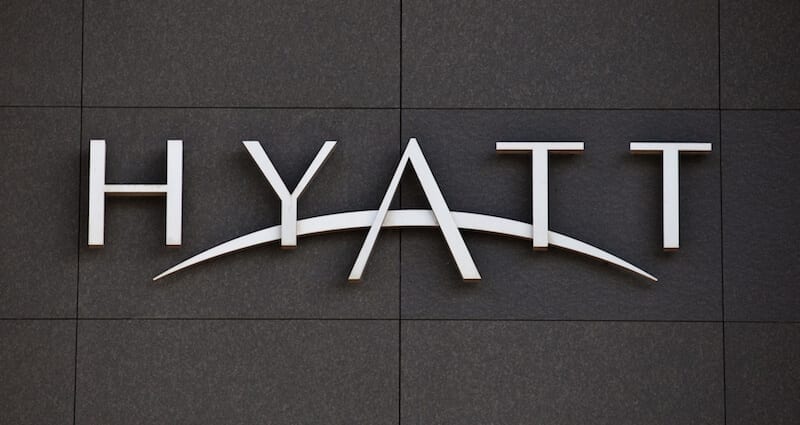
Year after year, Hyatt ends up on Fortune’s famous 100 Best Companies To Work For list. The hotel brand also enjoys a high ranking within the list, landing in the ninth spot in 2018. Hyatt treats employees like family, caring for them on a professional and personal level. By creating a thriving environment, Hyatt is considered one of the best places to work in the world.
Employees don’t just stay at Hyatt; they love working at Hyatt. A Great Place to Work® survey found that 95% of Hyatt employees say “I’m proud to tell others I work here.”
So why do employees love working at Hyatt?? The Hyatt philosophy is people-centered, regardless if it related to a customer or an employee.
By bringing out the best in employees, Hyatt knows it can deliver the best possible hotel experiences. Talk about premium hospitality, right?
One employee summarizes why it’s wonderful to work at Hyatt:
“Hyatt takes care of their employees. Training is so thorough that there’s nothing for you to guess about.”
We hope you find inspiration in these takeaways from Hyatt’s world-class employee engagement and retention techniques.
Takeaway #18 – Integrate well-planned retention initiatives into your core business strategy
Integrate well-planned retention initiatives into your core business strategy Click To TweetRepetitive tasks, many open positions, pay disparities, and lack of internal advancement opportunities contribute to the hospitality industry’s high turnover estimated to be a high 73.8 percent annual rate. Hyatt, however, enjoys a much lower level

“In an industry with historically high turnover, we are honored to have more than 14,000 colleagues with 15+ years of service – proof of the positive impact of our effort,” Hyatt says. And according to HubEngage, Hyatt housekeeping employees usually stay on board for 12 years or longer—practically a lifetime in the hospitality field.
Hyatt keeps turnover down with retention initiatives that are also central to the overall business strategy. Their retention initiatives include an in-depth training program that fuels employees’ internal advancement, a Caring Fund for employees suddenly facing emergency situations, and diversity and inclusion initiatives that make sure all employees can meet goals and enjoy satisfying work lives. For example, Hyatt established Diversity Business Resource Groups that bring together employees who share cultures, races, genders, ages, and interests.
These in-depth initiatives take time, energy, strategic thinking, and devotion to employees, so naturally, employee happiness and loyalty follow.
Takeaway #19 – Empower employees by offering support and security
Empower employees by offering support and security Click To TweetEmployee empowerment is at the heart of all Hyatt’s training and development initiatives. The hotel chain recognizes the value of investing in employees who, in turn, invest in their work and deliver committed performance that shines through in Hyatt’s spotless rooms, dedicated customer service, and pristine events.
In addition to training employees on key skills, Hyatt empowers employees by treating them like family members.
“Our commitment to caring for people starts first with our colleagues because they are the heart of Hyatt. Our focus is on listening and cultivating an environment where our colleagues can be their true selves – one where their career development is supported, their uniqueness is celebrated, their voices are heard, and collaboration and innovation are encouraged. We refer to ourselves as “the Hyatt family,” because it really feels that way,” Hyatt says.
Creating a family environment requires the cultivation of safety and security—some of the most empowering emotions employees can experience. Secure employees are motivated to solve problems, come up with new ideas, and take measured risks that lead to company-wide excellence.
Takeaway #20 – Develop and promote existing employees
Develop and promote existing employees Click To TweetHyatt chooses to spend time and energy developing internal employees, preparing them for advancement through their own corporate training program. This allows the hotel to fill positions with trusted employees who know their business instead of spending millions of dollars recruiting candidates who also require training and may not be around for much longer than a year.
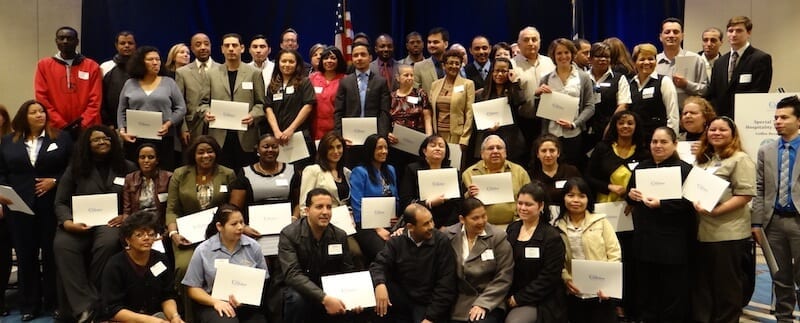
“We are proud to say that many Hyatt leaders grew their careers from entry-level roles with the company, and we support opportunities for our colleagues to move between functions and locations for professional and personal development,” Hyatt says.
HubEngage reports that Hyatt offers, in addition to a robust internal training effort, one-off classes and training sessions from Khan Academy and generous tuition reimbursement programs for employees looking to learn new on-the-job skills.
Conclusion
As you can see, effective employee retention strategies come in all shapes and will look different depending on a variety of factors including your industry, the size of your organization, as well as its culture and demographics.
However, certain themes appear over and over again, including trust, collaboration, values and purpose, personal development, and authentic communication. Use these ideals as a guiding principle when developing or refreshing your retention strategy.
How can you effectively retain employees?
There are many strategies you can employ to help boost your employee retention rates at your business. First and foremost, you should focus on areas that can be improved upon immediately. Sending out an employee wellness survey can help to identify those areas without directly asking employees why they would consider leaving. You can also review your employee recognition program to find ways to update it and try new ideas that encourage staff to recognize strong performance.
Which of these examples resonate with you? What does your company do differently to keep its top talent? Let us know in the comments below.

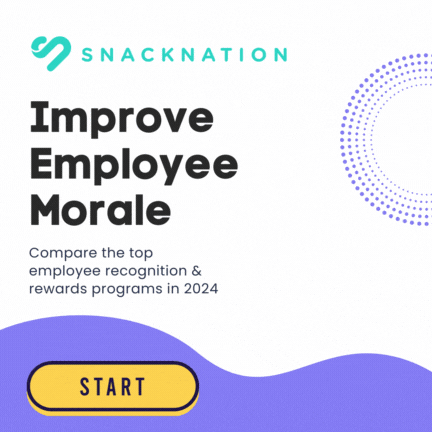






Amazing article! Vital content!
The Golden Handcuffs come in many forms. Personally I believe that seniority and tenure can fall in line with the other examples in this article. The skills we develop and sharpen over time (regardless of the industry they were formed in) are still relevant skills when it comes to things like Sales, Human Resources, Business Development, Business Consulting, Marketing, etc. Someone with a fresh perspective can add tons of value to a team that has been in place for years, and when we welcome those people and their ideas, we all benefit!
Makes sense. The netflix model over all seemed to be a dead ringer, but the other all had great ideas too. Thanks SnackNation for the ideas. 😀
Hi Hannah,
Great to hear you found this article helpful! Glad you’re enjoying the blog
Going to foward this to those in charge! This is such a positive acticle we all can benefit!
Thanks, Jodi! We’d love to hear what your company implements from this article.
One point I don’t agree with is the concept of “unlimited vacation” (e.g. what Netflix offers). Often times I think that this is ineffective because employees worry about asking for time off, taking more time off than their co-workers, feeling pressure to work while on vacation, etc. Instead, I think it’s more effective when employees are given an ample amount of PTO and are encouraged to utilize it.
That’s a really good point, Rochelle. Employees being afraid to take time off is a pitfall that cultural leaders have to actively avoid. I think the key, like you said, is to cultivate an atmosphere in which employees are encouraged to take advantaged of the policy. That often starts with top leadership and managers setting an example by actually taking time off when they need it.
Definitely going to share this with a few people. Our current retention rate could use some work.
Thanks Wes, let us know what tactics you end up deploying and how they work for you.
This article is really great! I will be sharing this tips too…thanks
Trust and collaboration are HUGE at the company I work for and I can see, firsthand, that it makes for a tighter crew and directly attributes to low turnover.
Very helpful article!
Make sense, having a good boss inspires you to want to work for them. Makes a well rounded team!
I love the idea of empowering employees to help in the decision making process. We do that in our office and it makes a huge difference in moral, the employees feel relevant and respected.
Having a leadership team that walks the walk is so important.
Great article. As an employee-owned company, we have a pretty awesome incentive for hiring and retaining talent, but it’s always nice to see what other companies are doing.
I forwarded this information to the VP of Human Resources and I think this would be helpful to our organization.
I like that these companies are recognizing that their employees desire to be valued. We are human after all, recognition of hard work inspires confidence.
Turnover costs more than hard dollars – it costs team morale! Thanks for the tips.
Great article. More companies should pay attention to what their employees actually want, not what they think they want.
great articles with great examples.
One of the biggest challenges, for sure!
Great Info!
I love these case studies! Employee Engagement is such a big part of the new workforce.
My company is small but it still need to improve on their employee retention
This is fantastic! One of the most challenging aspects of employee retainment is making Employee feel appreciated and as if they are a valuable part of the company and its success.
I have worked at (and left) so many places that didn’t understand these things – particularly Takeaway #2 – Treat employees like adults!
These case studies provide valuable insight into what makes better companies. Valuable takeaways!
I love these case studies. It’s nice to read concrete examples of lofty concepts. Would love to see more content like this!
Love Takeaway #7 – create a culture of ownership – full transparency, no excuses
I’m going to utilize a lot of what I learned here in my own office.
We find anniversary awards (trophies) and rewards (gifts) to be an effective tool for retaining employees.
Hiring A players is my first rule of thumb for my team. We are all top notch, and therefore, really enjoy working with each other. There is no weak link, and we build each other up.
Great article! It is really helpful.
This article gives me some hope, especially when I’ve seen in my experience that company culture is being sacrificed for the bottom line. I understand that to an extent and to limit frivolity, but to attract and keep talented people, they need to take pride in their work environment… This is a great read.
True, there is a balance that can be tricky to maintain, fun but getting business done.
we have quarterly and monthly in house events to encourage bonding and friendships. its just as important WHO you work with .
Awesome article- sharing this widely. So positive!
Very helpful. I think any business small or large could use these tips to help with retention!
The company I work for seems to take a few ascpects from each of these case studies. Overall though I think we follow the same trend as Netflix. To have a great community and work environment it starts in the hiring section. interviews are not only with the heads of the department but also with the colleagues they would be working with daily. I think this helps judge if they will be a good fit. This allows people in the company to stay longer as they are happy to work with those around them.
Really fascinating case studies, with lots of lessons to learn.
I completely agree with all points made! This is a must read for managers
This is a great article, and certainly a must-read for all managers and execs! I think often more emphasis is placed on a resume and experience, while an interview should try to discover a person’s character. Character and personality and equally if not more important! How that person will work with others in a team setting will be crucial to the company’s success and retention rate. It’s equally important to like WHO you’re working with, not just the job and company.
Very informative article, covering some A+ companies. It is always so interested to see what other companies are doing and it gives me some ideas to incorporate within our corporate culture.
As an employee who is still in the entry level range, I can’t do much to implement any of these, but I did feel myself wishing that my current company operated more like these companies. My fave takeaways are: Treat adults like adults; Let your employees be their true selves at work; Don’t underrate the value of fun.
I love to see the differences in strategies in what makes companies successful! The company I work for lets employees be their true selves at work and also likes to promote fun in the workplace!
I loved this article and appreciated the different perspectives applied to these businesses. Each one seemed to offer a takeaway that I plan to discuss with leaders at my company.
Wonderful article! Strategies worth sharing with my team leaders.
It’s important to get your employees input on decisions. That way they feel they have something invested in your company.
I somehow missed the NYT article about amazon.com. I’m shocked that a company of that enormity can’t invest more in their employees. That “back door” information piece (kind of like a “my two cents”) is completely absurd. As the (SN) article went on to state, the person who is attacked never gets to defend herself…that does NOT fly in my book. I’m all about the “there’s two sides to every story.”
As for the other company case studies — all the YESs!
Great article! Our company does many of these things… glad to see were getting it right!
Agreed that hiring the right employees in the first place will help them enjoy the job more and vice versa!
This is all very interesting and helpful
Great article!
I feel Developing Great Managers is the cornerstone to a happy and empowered organization.
Be transparent, set proper expectations, under promise and over deliver. Be authentic, you truly have to care about your team; know what they want from a career perspective and know what they want from a life perspective. Work life balance is crucial. If your team knows you truly care about them and helping them reach their goals, they will take care of you when the going gets tough and when you need them the most.
A lot of helpful information and a must read for all office managers.
Awesome Article! Gotta have fun to stay alive and healthy and in our office, we’re nothing but fun!
Takeaway #2 – Treat employees like adults
Takeaway #6 – Let your employees be their true selves at work
Top two, in my opinion. I’ve left companies that treated their employees like children. Micromanaging and nagging your employees is a sure fire way to send them running back out of the door.
Great article!!
Wonderful! I’ll be sure to keep this all in mind for the future!
I loved this. Learned so much, love to hear about what’s working / not working for other companies
Really informative article. Thanks for the tips!
Great article, I love the case studies. We are small and established with so much potential but very little money. I love the idea of focusing on recognition, careers, some fun that isn’t costly and walking the talk. Those are things we can do!
Glad to hear it! Thanks, Lois!
I really like the real life case studies which came from successful and top companies.
Thanks, Ayesha!
Great read, thanks for the tips !
Happy to help, Selena!
In the non-profit world, it’s harder to compete with the big perks or private companies – I like that many of these tips require more culture and less cash.
Good point – thanks for the feedback, Kendra!
Sharing this with our hr department!
We are constantly looking to Netflix as ahead of the curve for many employee engagement and retention initiatives. I love takeaway #2 “treat employees like adults”.
Simple, yet powerful! Thanks for sharing, Kate.
Love this article! Great message for all employers to read and consider.
I loved this. Learned so much, love to hear about what’s working / not working for other companies
Thanks, Luis!
Thank you for giving this meaningful information. HR is not only about recruitment only, the idea of these conference is to provide new learning about the technology updates in the marketplace. One can see and make contact with tech giants, CEOs and various designated people around the world.
So true! HR is a constantly evolving department like any other in an organization. Conferences are an invaluable tool in staying ahead of the curve! Thanks for sharing, Steve!
Really informative article. Thanks for the tips!
Happy to help, Michael!
Very helpful. I think any business small or large could use these tips to help with retention!
Glad you found it helpful, Jhon!
This has a great content. In a world where there are various companies with different leadership styles, culture and environment, retaining employees is a big deal. As one who belongs in a recruitment firm in the Philippines, it’s already common for me to engage in conversations with fellow recruiters in Manila re: keeping employees specially those who contribute greatly in the organization. Reading this article gives me more points to ponder on. In the field where everything is competitive, it is a must to step up and continue moving and adapting to changes. Keep making quality content!
Great points, Sandrene! So glad to hear you found this article helpful!
Going to foward this to those in charge! This is such a positive acticle we all can benefit!
Glad to hear it, Thomas. Thanks for sharing!
Wonderful! I’ll be sure to keep this all in mind for the future!
Very good publication, how important is communication within an organization
Working with great people is probably top on my list.
I love that one of the top takeaways is to treat employees like adults. Everything else grows from this one…giving responsibility, empowering them and development. Thanks for sharing!
The “Values-Driven Culture” is a great tip. That’s what we have at my current job and it has made for a great team.
Great article with a lot of insights !!! Thank you for sharing !!
Great article! Our company does many of these things… glad to see were getting it right!
great article to read. helpful things to think about as a person who is looking for a valuable place and people to work with, whether you’re on the lower or higher end of the spectrum in the workplace.
Thanks, Mel!
This has a lot of great ideas. Really motivates me to rethink and look outside the box and focus on other aspects or retention and ways to show appreciation.
Loves these ideas from other companies! Best way to learn is by leaning into what works (and hearing what doesn’t!).
Takeaway # 11 – Failures are your friend! That’s a unique approach and one I can imagine being beneficial to learning/sharing from our mistakes. Great insight!
I love this post. Not only do we need to stay competitive in the the general compensation packages, we also need to stay competitive in building up our employees.
Great post! Each case has many strong messages! Very much to learn from this. Definitely worth bookmarking!
There are a lot of great nuggets of information here that I think any company can learn from. I can also agree with the feelings reflected in these case studies such as, reviewing my position/value/purpose during anniversaries and looking for personal development opportunities.
I was happy to see that many of the takeaways are things that my current employer does. And it’s true that I am the happiest here than I have been anywhere in my career. But I wish these strategies could also impact our field employees, which is where our turnover is the highest. Unfortunately, it’s really hard to apply these strategies to wiremen and electrical relay technicians who work out in isolated substations. Our design engineers and other office employees benefit at least.
Love this article, I am sending this to our Leadership team to see if we can incorporate some of these philosophies!
I like Takeaway #16 – Integrate well-planned retention initiatives into your core business strategy. I think you need to think about how to keep employees from the top down and make it part of your culture.
Absolutely! Thanks for sharing, Rebecca!
Love takeaway #13. We’ve been trying to implement this more as an office! But question, how much fun is “too” much fun??
Hi Madison, great question! I think this is subjective to your office. What would be considered ‘too much fun’ at one company may be perfectly fine at another. I would use your best judgment and maybe loop in another coworker or supervisor for a second opinion.
Good info – thank you for sharing. It’s always great to get ideas and success stories from others.
Very factual suggestions are made in it. I got very useful information about the employee retention. All takeaways are explained with research mind.Thank you very much.
I think it’s important to remember to have fun at work – we recently upgraded our kitchen and break room and are adding a ping pong table to our common area.
Hey Donna! That’s very true since we spend most of our day at work! We are always excited for a ping pong tournament.
This is a great article, and our workplace has already implemented a few of these ideas. The ever changing dynamic of a startup means that keeping employees engaged and happy is so important.
Great post. Employee engagement is something we’re working on here in our Marketing division; we have to listen to our team and understand what is important to everyone, then deliver on it. If we don’t, we lose great people to competitors who are willing to give them what they need to be satisfied in their roles.
Hey Mia! Yes, that’s honestly a great point.
Great post! Thank you for sharing!
Excellent post!! Many thanks, I am a Business English teacher at a university in Colombia and I used this infomation to make my students create a presentation.
Very useful and thanks again!
Thanks Juan for featuring us in your presentation. We hope your students get a lot of use from this information!
Genuine and authentic content that educates several minds. Thanks for sharing such a piece of wonderful information. The best writing piece ever read on the internet that motivates to learn something new.